
Wing Tsun is said to have been created nearly 300 years ago in China by the Buddhist Mistress Ng Mui. She was highly skilled in Kung-Fu and was a refugee from the Shaolin Temple after it had been destroyed in the 1700s by both Manchurian soldiers and defectors from within the Shaolin Temple itself. Having travelled around the country for some time, she settled in the White Crane Temple at Tai Leung Mountain on the border between Szechwan and Yunnan. Ng Mui wanted to create a new fighting system which would enable her to overcome the Kung-Fu practised by the defectors from the Shaolin Temple. She did this after witnessing a fight between a fox and a crane. The fox kept moving in circles in order to attack the flank of the crane however the crane kept pivoting in order to keep its beak pointing at the fox and used this to attack. This provided the initial idea for Ng Mui to develop an improved system of Kung-Fu that emphasised method over strength.
Miss Yim Wing Tsun also lived at the foot of Tai Leung mountain with her father. There was a bully called Wong living in the area who asked for Wing Tsun's hand in marriage with the additional threat that if she refused then he would force her to marry him. When Ng Mui heard about Yim Wing Tsun's problems she offered to teach her Kung-Fu so that she would be able to defeat Wong herself. Within three years of hard training while living with Ng Mui in the convent, Yim Wing Tsun attained competence in learning the new system of Kung-Fu. She sent word to Wong that she would only marry someone who could defeat her in a fight. Wong was surprised but pleased and hastily accepted Yim Wing Tsun's offer of a fight. However he was quickly defeated by Yim Wing Tsun and subsequently left the area. When Yim Wing Tsun later married she taught her Kung-Fu to her husband, Leung Bok Chau who named the art Wing Tsun in honour of her.
Leung Bok Chau later taught Wing Tsun to a herbalist named Leung Lan Kwai who went on to teach Wong Wah Bo. Wong Wah Bo was a performer with the Red Junk Opera Company. Based in Fatshan the company travelled in pairs of long, narrow, flat-bottomed junks performing Cantonese Opera in small settlements in the Canton Delta. Each pair housed close to 140 performers, cooks, stage-hands and guards. The area and time in which the company operated were very dangerous. The Ming dynasty had overthrown the Qing dynasty and the opera companies were heavily linked with revolutionary activity. On top of this the Canton Delta was home to almost 50,000 pirates and the Red Junks were a plump target. Typically the pirates would sneak up on larger boats and attack with long bamboo pikes before boarding when they switched to a short heavy sword.
According to the Hong Kong Heritage Museum, members of the opera company practiced their martial arts on a wooden stump in the middle of the boat. This could have simply been the mast but is also likely to be the origin of the Wing Tsun wooden dummy (Muk-Yan Chong). The junks were propelled using long poles which were also used to defend against and fend off the pirates' bamboo pikes. From here we see a direct link to the Wing Tsun Long Pole (Luk Dim Boon Kwun). Finally, if boarded, fighting on the narrow walkways on the barge required small steps and effective close quarter techniques. As well as this, since the pirates were armed with short swords, the company would have armed themselves in a similar manner using swords that could also trap the long pikes, thus Wing Tsun's Bart Cham Dao.
Another member of the Red Junk opera company, and a friend of Wong Wah Bo, was Leung Yee Tei who, in his old age, taught Wing Tsun to a Fatshan doctor named Leung Jan. Dr. Leung Jan set up a Wing Tsun school in Fatshan and soon became a celebrity through the many challengers he faced and defeated.
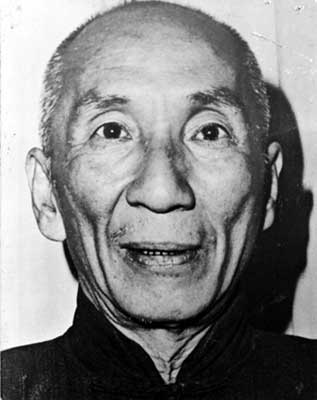
The late Grandmaster Yip Man
Yip Man was born into a wealthy family in Fatshan, in 1893 and at the age of 11 began to study Wing Tsun. His teacher was Chan Wah Shun and Yip Man was the youngest of 16 disciples. He studied Wing Tsun with Chan Wah Shun for about two years and when his teacher died, studied with the most senior instructor until he was 16. While attending school in Hong Kong he met Leung Bik who was the son of Dr. Leung Jan. Leung Bik was also skilled in Wing Tsun but had a deeper knowledge of the system. Yip Man trained with Leung Bik for many years and found when he returned to Fatshan aged 24, that he had a greater level of skill than his colleagues. While he gained a reputation as a great martial artist he accepted very few students.
Following the end of the Chinese Civil war, Yip Man moved to Hong Kong in 1949 where he began to teach Wing Tsun initially to only a small number of students as had long been the tradtion. He later taught it publicly and virtually all branches of Wing Tsun/Wing Chun being taught today come from him. Wing Tsun was not very popular with members of the public as it lacked the beautiful movements found in other martial art styles however it gained recognition for its success in challenge matches with other schools which were common in Hong Kong at the time.
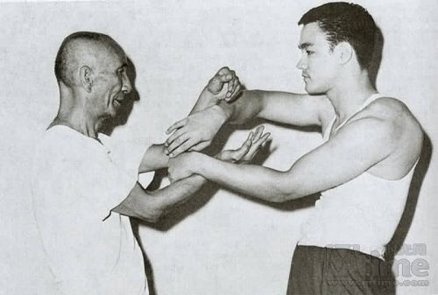
Yip Man performing Chi-Sau with a young Bruce Lee
It was during one of these challenge matches that Yip Man's student, Bruce Lee, hurt his opponent so severely that the police got involved. Lee's father, worried for his son's future, sent him to America where he became a famous martial artist and actor.
Wing Tsun was especially popular with members of the police force who appreciated its practical fighting value. As Yip Man's students became more advanced they were able to help him promote and teach Wing Tsun and with greater numbers of the public taking up the art Yip Man had to move into bigger premises on a regular basis. Yip Man continued to teach and promote Wing Tsun and in 1967 he founded the "Ving Tsun Athletic Association" (VTAA).
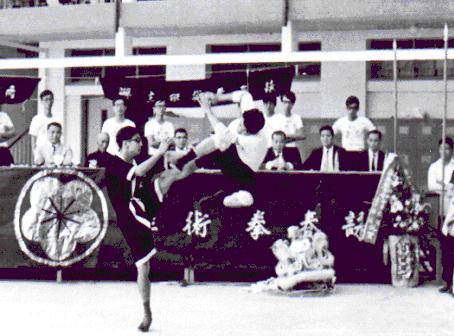
A young Leung Ting demonstrating Wing Tsun in college
Grandmaster Leung Ting was born in 1947 in Hong Kong and began Wing Tsun at the age of 13. Two of his uncles studied Wing Tsun and one of them introduced him to Leung Sheung who was one of Yip Man's first students in Hong Kong and a senior instructor. Leung Ting trained hard every day for six years and acted as an assistant instructor for his other uncle when he set up a school. In 1967 he set up a small school where he began to teach his own students and he also began to teach Wing Tsun in his high school. He started college in 1968 and was the first person to teach Chinese martial arts in a third level institution. This was somewhat of a first for Kung-Fu as it was seen by the public as a collection of tricks practised by thugs as opposed to the high esteem in which Karate and Taekwondo were held by the Japanese and Koreans.
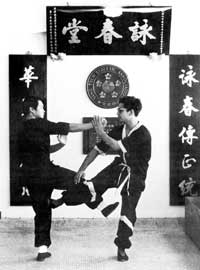
Leung Ting as Chief Instructor of the VTAA
The teaching of Wing Tsun in a 3rd Level institution was a significant milestone in the promotion of the art. Leung Ting's efforts didn't go unnoticed and Grandmaster Yip Man agreed to teach him privately once he came out of hospital. At the age of 20 Leung Ting became Yip Man's "closed door disciple" as the Grandmaster by this time had officially retired from teaching. As Leung Ting had already learned most of the Wing Tsun system, Grandmaster Yip Man had only to correct and refine his techniques.
Yip Man taught the most advanced techniques to Leung Ting for a period of about nine months and for a long time afterwards Leung Ting would invite Yip Man for afternoon tea. They would have long conversations on the theories and concepts of Wing Tsun so that Leung Ting's knowledge deepened long after the formal teaching finished. In 1970 Grandmaster Yip Man appointed Leung Ting as the Chief Instructor of the VTAA.
Yip Man died in 1972 finally succumbing to throat cancer. His legacy is that he brought a little known style of Kung-Fu from mainland China to Hong Kong and through hard work promoted it so that today Wing Tsun is one of the most popular martial art styles in the world. The recent "Ip Man" trilogy, although it presents a fictionalised account of his life, has boosted the public awareness of both Yip Man and his Wing Tsun Kung-Fu.
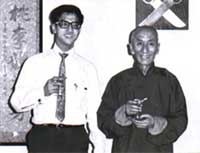
Yip Man and Leung Ting at the official opening of Leung Ting's school in 1970
When the VTAA moved premises in 1970, Leung Ting took over the building to run his own fully equipped gym. It was at this time that Leung Ting began to use the spelling "Wing Tsun" to refer to his school as opposed to the "Wing Chun"/"Ving Tsun" of Yip Man's other students. Leung Ting later registered the name "WingTsun" as an international trademark. WingTsun distinguishes itself from Wing Chun/Ving Tsun (WC/VT) in two main ways. The first is that the art itself is different from WC/VT. This was due to Leung Ting's time as an advanced student of Yip Man and also because of his changes to what he learned from the Grandmaster.
Leung Ting modified some aspects of the system in order to deal with fighters from other styles. He was conscious of the fact that many teachers only taught Wing Chun techniques against Wing Chun attacks. Leung Ting was convinced that Wing Tsun is a flexible system that must be able to adapt to all situations. He therefore modified the system so it addressed all likely attacks enabling his WingTsun to be adopted by many police, army and law enforcement agencies around the world. Leung Ting also studied the training methods of ring based fighters and incorporated this into his teaching with the result that a lot of his students did very well in competitions.
Leung Ting also paid many visits to Yip Man's original students in Fatshan and discovered that what Yip Man taught them was different from what he later taught in Hong Kong. Leung Ting discovered that there were additions and deletions to the system over the years and by researching the roots of Wing Tsun he gained a greater understanding of the system. He incorporated these findings into his own "WingTsun" and found that they greatly contributed to the effectiveness of the system.
The second main difference between Leung Ting's WingTsun and other Wing Chun schools was in his approach to school management. Leung Ting was very heavily involved in the promotion of WingTsun and was the first one to introduce a school uniform. He also divided the syllabus into separate student grades with examinations so that no student could move onto a more advanced grade without having learned everything for the more basic grade. This meant that there was consistency in the standard between all students and meant that no student missed out on important information just because they missed a particular class. This approach proved very popular and Leung Ting soon had one of the most successful Kung-Fu schools in Hong Kong.
On the 24th of July 1973 Leung Ting formed the "Leung Ting Wing Tsun Martial Arts Association" which has since then been renamed the "International WingTsun Association" (IWTA), one of the largest martial art organisations in the world.






